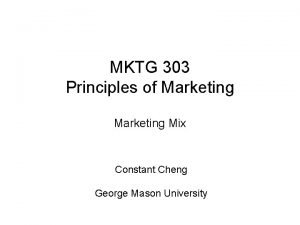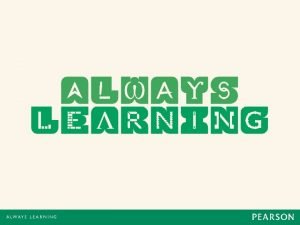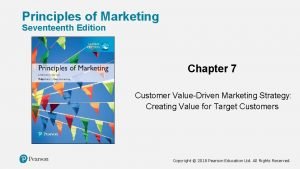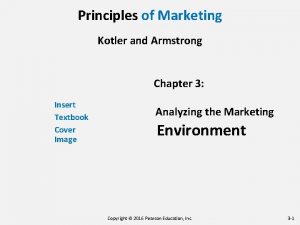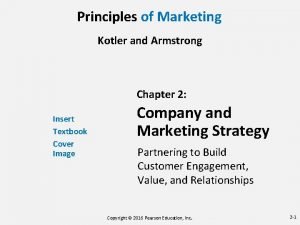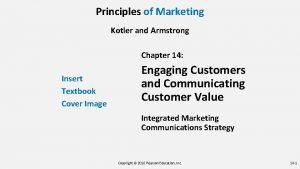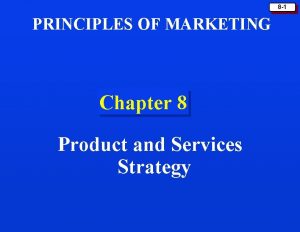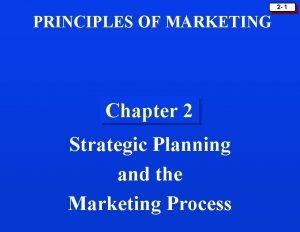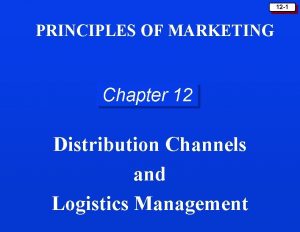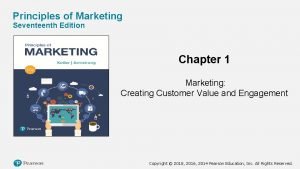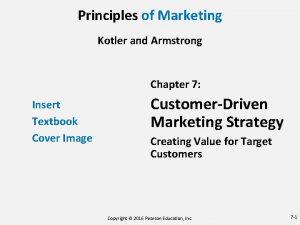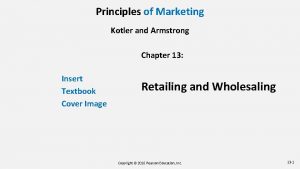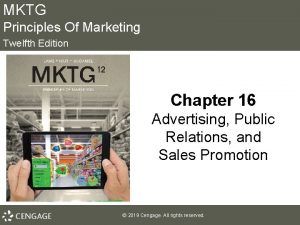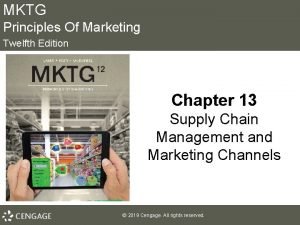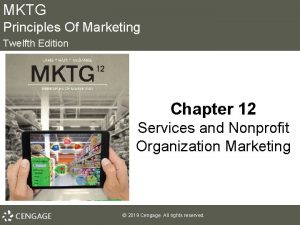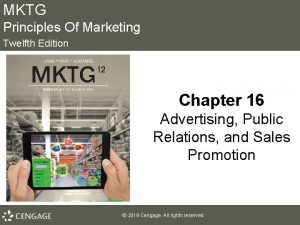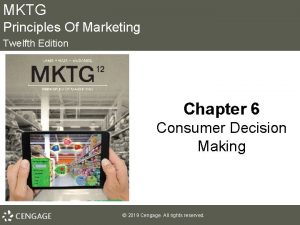MKTG Principles Of Marketing Twelfth Edition Chapter 4











































- Slides: 43

MKTG Principles Of Marketing Twelfth Edition Chapter 4 The Marketing Environment © 2019 Cengage. All rights reserved.

Learning Outcomes (slide 1 of 2) 4 -1 4 -2 4 -3 4 -4 4 -5 Discuss the external environment of marketing and explain how it affects a firm Describe the social factors that affect marketing Explain the importance to marketing managers of current demographic trends Explain the importance to marketing managers of growing ethnic markets Identify consumer and marketer reactions to the state of the economy © 2019 Cengage. All rights reserved.

Learning Outcomes (slide 2 of 2) 4 -6 4 -7 4 -8 Identify the impact of technology on a firm Discuss the political and legal environment of marketing Explain the basics of foreign and domestic competition © 2019 Cengage. All rights reserved.

The External Marketing Environment • Target market: a group of people or organizations for which an organization designs, implements, and maintains a marketing mix to meet the need of that group, resulting in mutually satisfying exchanges • Important for marketing managers in order to plan for the future • Environmental scanning involves: – Understanding current customers – Understanding how customers make decisions – Identifying the most valuable customers and understanding their needs – Understanding the competition © 2019 Cengage. All rights reserved.

Social Factors • Social change is the most difficult external variable for marketing managers to forecast, influence, or integrate into marketing plans • Social factors influence: – – Products people buy Price paid for products Effectiveness of specific promotions How, where, and when people expect to purchase products © 2019 Cengage. All rights reserved.

American Values • America’s core values have strongly influenced Americans’ attitudes and lifestyles – – – Self-sufficiency Upward mobility Work ethic Equality Individualism Achievement orientation © 2019 Cengage. All rights reserved.

The Growth of Component Lifestyles • Component lifestyles: the practice of choosing goods and services that meet one’s diverse needs and interests rather than conforming to a single, traditional lifestyle • Increase the complexity of consumers’ buying habits © 2019 Cengage. All rights reserved.

How Social Media Have Changed Our Behavior • Changed the way information is obtained and consumed • Made consumers: – Interact – Share beliefs, values, ideas, and interests – Purchase at a dizzying rate • Social media are web-based technology for creating and exchanging content © 2019 Cengage. All rights reserved.

How Firms Use Social Media • Firms can use social media to: – Engage customers in their products and services – Converse with customers and establish connections – Humanize brands • Emerging social media trends – Use own employees in social media promotions – Increased sophistication of social media promotion – Build goodwill for products © 2019 Cengage. All rights reserved.

Discussion Point Social Factors • Read the following: – Dove’s Real Beauty advertising campaign featured women of all ages, races, and body types – Nike ran an advertisement during the Grammy Awards encouraging people to “take the fairness and respect they see in sport and translate them off the field” – Garmin’s advertising campaign for its Vivoactive fitness tracker encourages users to “beat yesterday” – Keller Graduate School of Management ran a print advertisement that said, “See Jane Run The Company” What American value does each of the examples address: self-sufficiency, upward mobility, work ethic, equality, individualism, or achievement orientation? © 2019 Cengage. All rights reserved.

Demographic Factors • Demography: the study of people’s vital statistics, such as age, race and ethnicity, and location • People are the basis for any market – Demographic characteristics are related to consumer buying behavior – Population is the basic statistic in marketing – It is useful when broken into smaller and more specific increments © 2019 Cengage. All rights reserved.

Tweens • Live in a period of transition—bridging between being a kid and being a teenager • Seven developmental needs of tweens: – – – – Physical activity A sense of accomplishment and achievement Self-definition Creative expression Positive social interaction Structure and clear limits Meaningful participation © 2019 Cengage. All rights reserved.

Teens • Teens spend a lot of time using media • Many teens pass technology down to their parents • They command an immense amount of buying power © 2019 Cengage. All rights reserved.

Generation Z • Generation Z: people born between 1995 and 2010 • Have never known a world without social media or smartphones • Gen Z embraces multiculturalism as a touchstone of who they are • Have high product and service quality expectations © 2019 Cengage. All rights reserved.

Millennials (Generation Y) • Millennials: people born between 1979 and 1994 • Are currently in two stages: – People born in 1994 have entered young adulthood – People born in 1979 have established careers and have started families • Gen Yers are more idealistic and eager to please • Exposed to digital world from childhood – Influences what they buy, how they buy, and how they use the purchased products © 2019 Cengage. All rights reserved.

Generation X • • Generation X: people born between 1965 and 1978 Independent, resilient, and adaptable Saving money is a major priority for Gen Xers Most plan to keep working during their retirement years • Many support their aging parents • Place a high value on education and knowledge © 2019 Cengage. All rights reserved.

Baby Boomers • Baby Boomers: people born between 1946 and 1964 • Outspend younger adults on consumer goods and services • Make purchase decisions based on price and quality • Influenced by traditional advertising, sales reps, and word-of-mouth recommendations © 2019 Cengage. All rights reserved.

Marketing to Hispanic Americans • Largest group to use mobile devices for any type of transaction • Hispanic Millennials: – Embrace their original culture – More open-minded about relationships than their parents – Prone to taking a bilingual, bicultural approach to their media consumption © 2019 Cengage. All rights reserved.

Marketing to African Americans • Young population with a strong influence on the latest trends – 53 percent are under the age of 35 • Expect brands to support social causes • African American Millennials make innovative use of mobile technology © 2019 Cengage. All rights reserved.

Marketing to Asian Americans • Called a marketer’s dream as they are younger, better educated, and have higher incomes than average • Hold on to their cultural values • Cultural values are apparent in different groups © 2019 Cengage. All rights reserved.

Economic Factors • Economic factors of interest to marketers: – Consumers’ incomes – Inflation – Recession © 2019 Cengage. All rights reserved.

Consumers’ Incomes • U. S. incomes have risen in the last several years • Education is the primary determinant of earning potential • 13 percent of college-educated workers earn six figures or more • A person with a bachelor’s degree will earn more than twice as much total income as a nondegree holder © 2019 Cengage. All rights reserved.

Purchasing Power • Purchasing power: a comparison of income versus the relative cost of a standard set of goods and services in different geographic areas • Also known as the cost of living • Difference between the income and the cost of living (expenses) • Consumers with high purchasing power have the ability to purchase higher-priced necessities © 2019 Cengage. All rights reserved.

Inflation • Inflation: a measure of the decrease in the value of money, expressed as the percentage reduction in value since the previous year • Businesses can increase their profit margins only by increasing their efficiency during low inflation • Regardless of what happens with cost, the buyer is not going to pay more for a product than the subjective value he or she places on it © 2019 Cengage. All rights reserved.

Recession • Recession: a period of economic activity characterized by negative growth, which reduces demand for goods and services • Also defined as occurring when the gross domestic product falls for two consecutive quarters – Gross domestic product (GDP) is the total market value of all final goods and services produced during a period of time © 2019 Cengage. All rights reserved.

Technology and Innovation • Technological success is based upon innovation • Corporate structure and management actions are required to bring new technology • Workers should be encouraged to innovate © 2019 Cengage. All rights reserved.

Research • Basic research: pure research that aims to confirm an existing theory or to learn more about a concept or phenomenon – Over time, basic research often leads to innovations in the marketplace • Applied research: research that attempts to develop new or improved products © 2019 Cengage. All rights reserved.

Stimulating Innovation • Companies limit innovation to areas they are already familiar with – Can lead to incremental progress, but rarely leads to a dramatic breakthrough • Different approaches to innovation include: – – – Building scenarios Enlisting the Web Talking to early adopters Using marketing research Creating an innovative environment Catering to entrepreneurs © 2019 Cengage. All rights reserved.

Political and Legal Factors • Business needs government regulation to protect innovators of new technology, the interests of society, and consumers • Government needs business in order to generate taxes that support public efforts © 2019 Cengage. All rights reserved.

Federal Legislation (slide 1 of 2) • Federal laws that affect marketing apply to competitive environment, pricing, advertising and promotion, and consumer privacy • A few key provisions of the Patient Protection and Affordable Care Act are: – – Large employers must offer coverage to full-time workers Workers cannot be denied coverage A person cannot be dropped when he or she is sick A worker cannot be denied coverage for a preexisting condition – Young adults can stay on their parents’ plans until age 26 © 2019 Cengage. All rights reserved.

Federal Legislation (slide 2 of 2) • The Dodd-Frank Act created the Consumer Financial Protection Bureau (CFPB) to oversee checking accounts, private student loans, mortgages, and other financial products – Has impacted U. S. businesses © 2019 Cengage. All rights reserved.

Exhibit 4. 1 Primary U. S. Laws that Affect Marketing (slide 1 of 2) Legislation Sherman Act of 1890 Clayton Act of 1914 Federal Trade Commission Act of 1914 Robinson-Patman Act of 1936 Impact on Marketing Makes trusts and conspiracies in restraint of trade illegal; makes monopolies and attempts to monopolize misdemeanors. Outlaws discrimination in prices to different buyers; prohibits tying contracts (which require the buyer of one product to also buy another item in the line); makes illegal the combining of two or more competing corporations by pooling ownership of stock. Created the Federal Trade Commission to deal with antitrust matters; outlaws unfair methods of competition. Prohibits charging different prices to different buyers of merchandise of like grade and quantity; requires sellers to make any supplementary services or allowances available to all purchasers on a proportionately equal basis. © 2019 Cengage. All rights reserved.

Exhibit 4. 1 Primary U. S. Laws that Affect Marketing (slide 2 of 2) Wheeler-Lea Amendments to FTC Act of 1938 Broadens the Federal Trade Commission's power to prohibit practices that might injure the public without affecting competition; outlaws false and deceptive advertising. Lanham Act of 1946 Establishes protection for trademarks. Celler-Kefauver Antimerger Act of 1950 Strengthens the Clayton Act to prevent corporate acquisitions that reduce competition. Hart-Scott-Rodino Act of 1976 Requires large companies to notify the government of their intent to merge. Foreign Corrupt Practices Act of 1977 Prohibits bribery of foreign officials to obtain business. © 2019 Cengage. All rights reserved.

Exhibit 4. 2 Primary U. S. Laws Protecting Consumers (slide 1 of 2) Legislation Impact on Marketing Federal Food and Drug Act of 1906 Prohibits adulteration and misbranding of foods and drugs involved in interstate commerce; strengthened by the Food, Drug, and Cosmetic Act (1938) and the Kefauver-Harris Drug Amendment (1962). Federal Hazardous Substances Act of 1960 Requires warning labels on hazardous household chemicals. Kefauver-Harris Drug Amendment of 1962 Requires that manufacturers conduct tests to prove drug effectiveness and safety. Consumer Credit Protection Act of 1968 Requires that lenders fully disclose true interest rates and all other charges to credit customers for loans and installment purchases. Child Protection and Toy Safety Act of 1969 Prevents marketing of products so dangerous that adequate safety warnings cannot be given. Public Health Smoking Act of 1970 Prohibits cigarette advertising on television and radio and revises the health hazard warning on cigarette packages. Poison Prevention Labeling Act of 1970 Requires safety packaging for products that may be harmful to children. National Environmental Policy Act of 1970 Established the Environmental Protection Agency to deal with various types of pollution and organizations that create pollution. Public Health Cigarette Smoking Act of 1971 Prohibits tobacco advertising on radio and television. © 2019 Cengage. All rights reserved.

Exhibit 4. 2 Primary U. S. Laws Protecting Consumers (slide 2 of 2) Consumer Product Safety Act of 1972 Created the Consumer Product Safety Commission, which has authority to specify safety standards for most products. Child Protection Act of 1990 Regulates the number of minutes of advertising on children's television. Children's Online Privacy Protection Act of 1998 Empowers the FTC to set rules regarding how and when marketers must obtain parental permission before asking children marketing research questions. Aviation Security Act of 2001 Requires airlines to take extra security measures to protect passengers, including the installation of stronger cockpit doors, improved baggage screening, and increased security training for airport personnel. Homeland Security Act of 2002 Protects consumers against terrorist acts; created the Department of Homeland Security. Do Not Call Law of 2003 Protects consumers against unwanted telemarketing calls. CAN-SPAM Act of 2003 Protects consumers against unwanted email or spam. Credit Card Act of 2009 Provides many credit card protections. Restoring American Financial Stability Act of 2010 Created the Consumer Financial Protection Bureau to protect consumers against unfair, abusive, and deceptive financial practices. Patient Protection and Affordable Care Act Overhauled the U. S. healthcare system; mandated and subsidized health insurance for individuals. © 2019 Cengage. All rights reserved.

State and Local Laws • Legislation that affects marketing varies state by state • Many states and cities are attempting to fight obesity by regulating fast-food chains and other restaurants © 2019 Cengage. All rights reserved.

Regulatory Agencies • Consumer Product Safety Commission (CPSC): a federal agency established to protect the health and safety of consumers in and around their homes • Food and Drug Administration (FDA): a federal agency charged with enforcing regulations against selling and distributing adulterated, misbranded, or hazardous food and drug products • Federal Trade Commission (FTC): a federal agency empowered to prevent persons or corporations from using unfair methods of competition in commerce © 2019 Cengage. All rights reserved.

Bureaus of the FTC (slide 1 of 2) • Bureau of Competition: – Reviews mergers and acquisitions – Challenges anti-competitive conduct and promotes competition – Provides information and holds conferences and workshops on competition issues • Bureau of Economics: – Provides economic analysis and support to antitrust and consumer protection investigations © 2019 Cengage. All rights reserved.

Bureaus of the FTC (slide 2 of 2) • Bureau of Consumer Protection: – Enforces federal laws that protect consumers – Empowers consumers with information – Communicates with consumers © 2019 Cengage. All rights reserved.

Consumer Privacy • CAN-SPAM Act: – Regulates unsolicited e-mail advertising – Prohibits commercial e-mailers from using false addresses and presenting false or misleading information • Children’s Online Privacy Protection Act: – Requires website operators to post a privacy policy on their home page and a link to the policy on every page where personal information is collected © 2019 Cengage. All rights reserved.

Competitive Factors • Management has little control over the competitive environment confronting a firm • Competition for market share and profits – Firms must work harder to maintain their profits • Global competition – More foreign firms are entering U. S. markets – Foreign firms in the United States now compete on product quality © 2019 Cengage. All rights reserved.

Key Terms (slide 1 of 2) • • • Target market Component lifestyles Demography Generation Z Millennials Generation X Baby Boomers Purchasing power Inflation © 2019 Cengage. All rights reserved.

Key Terms (slide 2 of 2) • Recession • Basic research • Applied research • Consumer Product Safety Commission (CPSC) • Food and Drug Administration (FDA) • Federal Trade Commission (FTC) © 2019 Cengage. All rights reserved.
 Mktg 12 principles of marketing
Mktg 12 principles of marketing Mktg 12th edition
Mktg 12th edition Mktg 12th edition
Mktg 12th edition Management ricky griffin 12th edition pdf download
Management ricky griffin 12th edition pdf download Bases for market segmentation
Bases for market segmentation Mktg erf
Mktg erf Sports entertainment definition
Sports entertainment definition Mktg 303
Mktg 303 Mktg 10
Mktg 10 Principles of marketing fifth european edition
Principles of marketing fifth european edition Principles of marketing arab world edition
Principles of marketing arab world edition Principles of marketing seventeenth edition
Principles of marketing seventeenth edition Principles of marketing grade 12 module 2
Principles of marketing grade 12 module 2 Using mis 10th edition
Using mis 10th edition Using mis (10th edition) 10th edition
Using mis (10th edition) 10th edition Structure of twelfth night
Structure of twelfth night Twelfth night ppt
Twelfth night ppt There is no woman's sides
There is no woman's sides Twelfth night characters
Twelfth night characters What is the main conflict in twelfth night
What is the main conflict in twelfth night Twelfth night act 1 scene 5
Twelfth night act 1 scene 5 I am not what i am twelfth night
I am not what i am twelfth night Themes in twelfth night
Themes in twelfth night Twelfth song of thunder figurative language
Twelfth song of thunder figurative language Twelfth night act 5
Twelfth night act 5 Setting of twelfth night
Setting of twelfth night A man lives on the twelfth floor of a tall building
A man lives on the twelfth floor of a tall building Msik
Msik Satire in twelfth night
Satire in twelfth night Deverell twelfth night
Deverell twelfth night I disappeared on the night before my twelfth birthday
I disappeared on the night before my twelfth birthday Ironic and humorous plays
Ironic and humorous plays Chapter 7 marketing
Chapter 7 marketing Marketing chapter 5
Marketing chapter 5 Principle of marketing chapter 3
Principle of marketing chapter 3 Principles of marketing pearson slides
Principles of marketing pearson slides Principles of marketing chapter 14
Principles of marketing chapter 14 Chapter 8 principles of marketing
Chapter 8 principles of marketing Principle of marketing chapter 2
Principle of marketing chapter 2 Marketing chapter 12
Marketing chapter 12 Principles of marketing chapter 3
Principles of marketing chapter 3 Chapter 1 marketing
Chapter 1 marketing 7 cs of marketing by philip kotler
7 cs of marketing by philip kotler Principles of marketing chapter 13
Principles of marketing chapter 13







